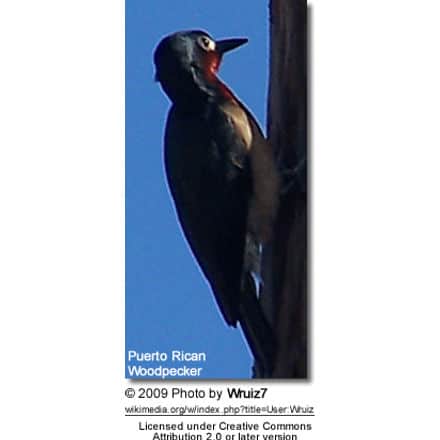Puerto Rican Woodpeckers
The Puerto Rican Woodpeckers (Melanerpes portoricensis) is the only woodpecker endemic to the archipelago of Puerto Rico and is one of the five species of Melanerpes sp. that occur in the Antilles.
Furthermore, it is the only resident species of the Picidae family in Puerto Rico. The species is common on the main island of Puerto Rico and rare on the island of Vieques.
The Puerto Rican Woodpeckers is a common and widely distributed species in Puerto Rico, mainly occurring in forests, coffee plantations, mangroves, palm tree groves, parks, and gardens.
Besides occurring in Puerto Rico it once inhabited the island of St. Croix.
This stems from the fact that during the Pleistocene epoch Puerto Rico, Vieques, Culebra, St. Croix, and the other Virgin Islands constituted a single landmass. It is believed that at this time the species extended its range to St.Croix and Vieques.
Description
The Puerto Rican Woodpeckers have a black body and a bright red throat and breast. It has a white patch that runs across the head from eye to eye. Its flanks and lower body have a light tangerine coloration.
As with the majority of birds sexual dimorphism (visual physical differences between the sexes) is present in this species.
The males’ throat and breast are more brightly colored than the females’ with females tending to be all-around duller in coloration.
There is also a substantial(~18%) difference in bill length between sexes.
Also, males are slightly bigger than females.
Its average weight is 56.0 grams. Its body length varies between 23 and 27 centimetres.
The Puerto Rican Woodpecker is said to resemble the behavior and structure of the North American Red-headed Woodpecker (Melanerpes erythrocephalus).
Member of the Picidae Family: Woodpeckers … Sapsuckers … Flickers

Diet
Like the majority of woodpeckers, this species uses its bill to drill holes in trunks in search of prey. The principal component of its diet is insects such as ants, beetle larvae, and others. Fruits are also important, composing one-quarter of its diet. Rarely it may eat scorpions, geckos, and coquís.
Breeding / Nesting
Females lay from 1 to 6 white eggs in cavities carved by males. The nests of M. portoricensis are used by other Puerto Rican endemic birds such as the Puerto Rican Flycatcher (Myiarchus antillarum) and the Yellow-shouldered Blackbird (Agelaius xanthomus).





